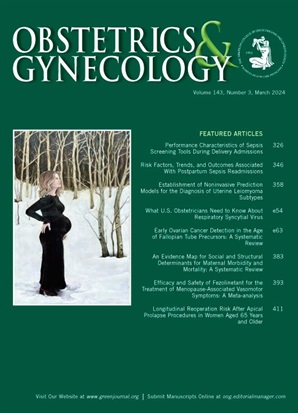妊娠期与非妊娠期获得严重急性呼吸综合征冠状病毒2 (SARS-CoV-2)组粒变异后的长冠状病毒
IF 4.7
2区 医学
Q1 OBSTETRICS & GYNECOLOGY
引用次数: 0
摘要
目的评价妊娠期感染严重急性呼吸综合征冠状病毒2型(SARS-CoV-2)的个体与感染病毒时未妊娠的个体发生长COVID的风险是否存在差异。方法在79个NIH RECOVER (research COVID - to - Enhance Recovery)站点开展多中心观察队列研究。纳入了在2021年12月1日或之后出生时年龄在18-45岁的女性(首次)SARS-CoV-2感染的个体。暴露于SARS-CoV-2感染时的妊娠期(任何胎龄)。主要结局为指数感染后6个月的长COVID,定义为基于详细症状调查的恢复-成人长COVID研究指数得分11或更高。为了解释感染时怀孕和未怀孕的参与者之间的混淆和差异选择,使用倾向评分匹配方法来平衡与怀孕状态和长COVID可能相关的变量组。结果共纳入2423名受试者;急性SARS-CoV-2感染时孕妇580例(23.9%)。感染时的中位年龄为33岁(四分位数范围为28-38岁),已知接种疫苗的参与者中有2131人(90.0%)接种了疫苗。倾向评分匹配后,指数感染后6个月的调整后长COVID患病率估计值在感染时怀孕的患者中为10.2% (95% CI, 6.2-14.3%),在感染时未怀孕的患者中为10.6% (95% CI, 8.8-12.4%)。妊娠与长COVID调整风险差异无关(调整风险比0.96,95% CI, 0.63-1.48)。结论妊娠期感染SARS-CoV-2与妊娠期外感染SARS-CoV-2与6个月时长COVID的差异风险无关。本文章由计算机程序翻译,如有差异,请以英文原文为准。
Long COVID After Acquisition of the Omicron Variant of Severe Acute Respiratory Syndrome Coronavirus 2 (SARS-CoV-2) During Pregnancy Compared With Outside of Pregnancy.
OBJECTIVE
To evaluate whether the risk of long COVID among individuals infected with severe acute respiratory syndrome coronavirus 2 (SARS-CoV-2) during pregnancy differs from that of individuals who were not pregnant at time of virus acquisition.
METHODS
We conducted a multicenter observational cohort study at 79 NIH RECOVER (Researching COVID to Enhance Recovery) sites. Individuals assigned female at birth aged 18-45 years with an index (first) SARS-CoV-2 infection on or after December 1, 2021, were included. The exposure was pregnancy (any gestational age) at the time of index SARS-CoV-2 infection. The primary outcome was long COVID 6 months after index infection, defined as RECOVER-Adult Long COVID Research Index score 11 or higher based on a detailed symptom survey. To account for confounding and differential selection between participants who were pregnant and not pregnant at infection, propensity score-matching methods were used to balance the groups on variables potentially associated with both pregnancy status and long COVID.
RESULTS
Overall 2,423 participants were included; 580 (23.9%) were pregnant at index SARS-CoV-2 infection. The median age at infection was 33 years (interquartile range 28-38 years), and 2,131 of participants (90.0%) with known vaccination status were vaccinated. After propensity score matching, the adjusted long COVID prevalence estimates 6 months after index infection were 10.2% (95% CI, 6.2-14.3%) among those pregnant at infection and 10.6% (95% CI, 8.8-12.4%) among those not pregnant at infection. Pregnancy was not associated with a difference in adjusted risk of long COVID (adjusted risk ratio 0.96, 95% CI, 0.63-1.48).
CONCLUSION
Acquisition of SARS-CoV-2 during pregnancy was not associated with a differential risk of long COVID at 6 months compared with similar-aged individuals who acquired SARS-CoV-2 outside of pregnancy.
求助全文
通过发布文献求助,成功后即可免费获取论文全文。
去求助
来源期刊

Obstetrics and gynecology
医学-妇产科学
CiteScore
11.10
自引率
4.20%
发文量
867
审稿时长
1 months
期刊介绍:
"Obstetrics & Gynecology," affectionately known as "The Green Journal," is the official publication of the American College of Obstetricians and Gynecologists (ACOG). Since its inception in 1953, the journal has been dedicated to advancing the clinical practice of obstetrics and gynecology, as well as related fields. The journal's mission is to promote excellence in these areas by publishing a diverse range of articles that cover translational and clinical topics.
"Obstetrics & Gynecology" provides a platform for the dissemination of evidence-based research, clinical guidelines, and expert opinions that are essential for the continuous improvement of women's health care. The journal's content is designed to inform and educate obstetricians, gynecologists, and other healthcare professionals, ensuring that they stay abreast of the latest developments and best practices in their field.
 求助内容:
求助内容: 应助结果提醒方式:
应助结果提醒方式:


